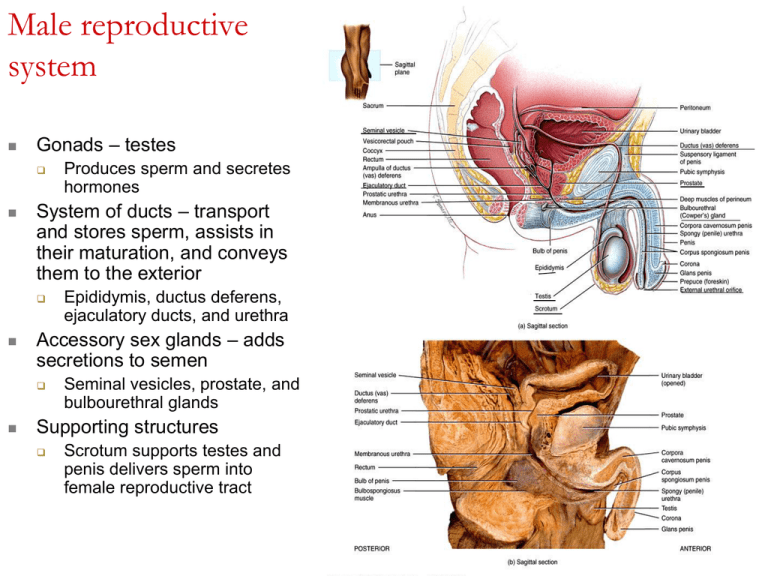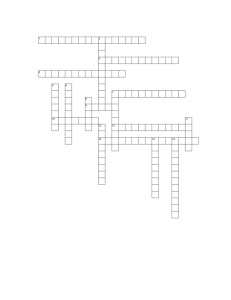Male reproductive system
advertisement

Male reproductive system Gonads – testes System of ducts – transport and stores sperm, assists in their maturation, and conveys them to the exterior Epididymis, ductus deferens, ejaculatory ducts, and urethra Accessory sex glands – adds secretions to semen Produces sperm and secretes hormones Seminal vesicles, prostate, and bulbourethral glands Supporting structures Scrotum supports testes and penis delivers sperm into female reproductive tract Scrotum Supporting structure for testes Scrotal septum – internally divides scrotum into two sacs, each with a single testis Made up of subcutaneous layer and dartos muscle (smooth) Associated with each testis is the cremaster muscle (skeletal) Normal sperm production requires a temperature 23°C below core body temperature Cremaster and dartos muscle contracts or relaxes Testes or testicles Paired oval glands in the scrotum Develops near kidney and descends through inguinal canals near 7th month of fetal development Tunica vaginalis partially covers testes Tunica albuginea – internal to tunica vaginalis Extends inward forming septa that divide testis into lobules Each of 200-300 lobules contains 1-3 seminiferous tubules Sperm produced here through spermatogenesis Seminferous tubule cells Spermatogenic cells – spermforming cells Spermatagonia (stem cell) develop from germ cells that arise in yolk sac and enter testes in 5th week of development spermatocyte spermatidspermatozoa Sertoli cells– support cells Tight junction form blood-testis barrier – prevents immune response against sperm cell surface antigens Nourish spermatocytes, spermatids and sperm, phagocytize excess spermatid cytoplasm, control movements of spermatogenic cells, release sperm into lumen, produce fluid for sperm transport, secrete inhibin, regulate effects of testosterone and follicle-stimulating hormone (FSH) Leydig (interstitial) cells found in spaces between seminiferous tubules Secrete testosterone Spermatogenesis Takes 65-75 days Begins with spermatogonia – diploid (2n) Primary spermatocytes – diploid (2n) Stem cells undergo mitosis to replace themselves and some continue development Each duplicates its DNA and meiosis begins Meiosis I – homologous pairs line up, crossing over occurs Secondary spermatocytes (haploid or n) Meiosis II – 2 chromatids separate 2 cells at end of Meiosis I Each chromosome made up of 2 chromatids attached at centromere Spermatids – 4 haploid cells at end of meiosis II Cells remain attached to each other by cytoplasmic bridges Spermiogenesis – development of spermatids into sperm Spherical spermatids transform into elongated sperm Acrosome and flagella form, mitochondria multiply Sertoli cells dispose of excess cytoplasm Spermiation – release from connections to Sertoli cells Not yet able to swim Sperm Each day about 300 million sperm complete spermatogenesis Head Tail Nucleus with 23 chromosomes (haploid or n) Acrosome – vesicle filled with oocyte penetrating enzymes Neck – contains centrioles forming microtubules that comprise remainder of tail Middle piece – contains mitochondria Principal piece – longest portion of tail End piece – terminal, tapering portion of tail Once ejaculated, sperm do not survive more than 48 hours in female reproductive tract Hormonal control of testes Androgens (testosterone and DHT) Prenatal development Development of male sexual characteristics At puberty, they bring about development of male sex organs and development of male secondary sexual characteristics Development of sexual function Testosterone stimulates male pattern of development or reproductive system ducts and descent of testes DHT stimulates development of external genitalia Androgens contribute to male sexual behavior, spermatogenesis and sex drive (libido) Stimulation of anabolism Stimulate protein synthesis – heavier muscle and bone mass in men 28_table_02 Male reproductive system ducts Spermatic cord Ascends out of scrotum Consists of ductus deferens as it ascends through scrotum, testicular artery, veins that drain testes and carry testosterone, autonomic nerves, lymphatic vessels, and cremaster muscle Reproductive system ducts in males Ducts of testis Epididymis Pressure generated by fluid produced by Sertoli cells push sperm along seminiferous tubules, straight tubules, rete testis, efferent ducts, then ductus epididymis Consists of tightly coiled ductus epididymis Stereocilia are microvilli that reabsorb degenerated sperm Site of sperm maturation – acquire motility and ability to fertilize Can store sperm for several months Continues as ductus (vas) deferens Ductus (vas) deferens Conveys sperm during sexual arousal through peristaltic contractions Can also store sperm several months Ejaculatory ducts Formed by union of duct from seminal vesicle and ampulla of ductus deferens Terminate in prostatic urethra Eject sperm and seminal vesicle secretions just before release of semen into urethra Urethra Shared terminal duct of reproductive and urinary systems Subdivided into prostatic urethra, membranous urethra, and spongy (penile) urethra Ends at external urethral orifice Accessory sex glands – secrete most of liquid portion of semen Seminal vesicles - About 60% of semen volume Prostate - About 25% of semen volume Secrete alkaline, viscous fluid containing fructose, prostaglandins, and clotting proteins (different from blood) Secretes milky, slightly acidic fluid containing citric acid, several proteolytic enzymes, acid phosphatase, seminalplasmin (antibiotic) Bulbourethral glands Secrete alkaline fluid that protects passing sperm by neutralizing acids from urine in urethra Mucus lubricates end of penis and lining of urethra Semen and Penis Semen Mixture of sperm and seminal fluid Typical volume 2.5-5 mL with 50-150 million sperm/mL Slightly alkaline pH of 7.2-7.7 due to seminal vesicle secretions Provides transport medium, nutrients, and protection Coagulates after ejaculation due to clotting proteins Penis Contains urethra Passageway for ejaculation of semen and excretion of urine Body of penis – 3 cylindrical masses of tissue with erectile tissue Glans penis – terminal opening is external urethral orifice Prepuce or foreskin covers glans in uncircumcised men Root of penis is attached portion Erection – parasympathetic fibers release and cause local production of nitric oxide (NO) causing smooth muscle in arterioles to relax and dilate allowing large amounts of blood to enter penis Abnormal conditions of Male reproductive system Cryptorchidism- “hidden testis” 3% full term males; 30% premature males Sterility Cancer risk30-50x higher Testicular cancer Most common cancer between 20-35 More than 95% arise from spermatogenic cells w/in seminiferous tubules Dull ache in lower abdomen; testicular heaviness; Early detection self exams Gently roll testicle between index finger and thumb Feel for lumps, swellings, or other changes Prostate cancer Leading cause of death from cancer in men in U.S. Each year 200,000 diagnosed; 40,000 deaths Prostate Specific Antigen (PSA) is produced only by prostate epithelial cells, increases with enlargement of prostate (many indicate infection, benign growth, or cancer) Blood test measures level of PSA (recommended for males over 50) Digital Rectal Exam (palpate gland via rectum) Vasectomy Portion of vas deferens is removed Remaining pieces are stitched closed Sperm production continues but can not reach exterior Sperm degenerate & destroyed by phagocytosis Testosterone levels remain the same If done correctly 100% effective Can be reversed; chance of regaining fertility is only 3040% Female reproductive system Gonads – ovaries Uterine (fallopian) tubes or oviducts Uterus Vagina External organs – vulva Mammary glands Ovaries Paired glands homologous to the testes Produce Gametes – secondary oocytes that develop into mature ova (eggs) after fertilization Hormones including progesterone, estrogens, inhibin and relaxin Series of ligaments hold ovaries in place Broad ligament – part of parietal peritoneum Ovarian ligament – anchors ovaries to uterus Suspensory ligament – attaches ovaries to pelvic wall Histology of ovary Ovarian medulla Contains blood vessels, lymphatic vessels, and nerves Ovarian cortex Ovarian follicles - consist of oocytes in various stages of development Surrounding cells nourish developing oocyte and secrete estrogens as follicle grows Mature (graafian) follicle – large, fluid-filled follicle ready to expel secondary oocyte during ovulation Corpus luteum – remnants of mature follicle after ovulation Produces progesterone, estrogens, relaxin and inhibin until it degenerates into corpus albicans Oogenesis and follicular development Formation of gametes in ovary Oogenesis begins before females are born Essentially same steps of meiosis as spermatogenesis During early fetal development, primordial (primitive) germ cells migrate from yolk sac to ovaries Germ cells then differentiate into oogonia – diploid (2n) stem cells Before birth, most germ cells degenerate – atresia A few develop into primary oocytes that enter meiosis I during fetal development About 200,000 to 2,000,000 at birth, 40,000 remain at puberty, and around 400 will mature Each month from puberty to menopause, FSH and LH stimulate the development of several primordial follicles Usually, only one reaches ovulation Oogenesis Summary of oogenesis and follicular develop ment Uterine (fallopian) tubes or oviducts Provide a route for sperm to reach an ovum Transport secondary oocytes and fertilized ova from ovaries to uterus Infundibulum ends in finger-like fimbriae Produce currents to sweep secondary oocyte in 3 layers Mucosa – ciliary conveyor belt, cells provide nutrition to ovum Muscularis – peristaltic contractions Serosa – outer layer Uterus Anatomy Fundus, body, isthmus, and cervix (opens into vagina) Normal position is anteflexion – anterior and superior over bladder Histology – 3 layers 1. 2. 3. Perimetrium – outer layer Part of visceral peritoneum Myometrium 3 layers of smooth muscle Contractions in response to oxytocin from posterior pituitary Endometrium – inner layer Highly vascularized Stratum functionalis – lines cavity, sloughs off during menstruation Stratum basalis – permanent, gives rise to new stratum functionalis after each menstruation Uterus Blood supply Essential to support regrowth after menustration, implantation and development of placenta Cervical mucus - produced by secretory cells of cervix mucosa (20-60ml/day) Water, glycoproteins, lipids, enzymes, and inorganic salts More hospitable to sperm near ovulation – thinner, more alkaline Supplements energy needs of sperm, protect sperm from phagocytes and hostile environment of tract Plays a role in capacitation Vagina Fibromuscular canal extending from exterior of body to cervix Mucosa continuous with uterine mucosa Decomposition of glycogen makes acidic environment hostile to microbes and sperm Alkaline components of semen raise pH Muscularis – 2 layers of smooth muscle Adventitia – anchors vagina to adjacent organs Vulva – external female genitalia Mons pubis – cushions pubic symphisis Labia majora – homologous to scrotum Labia minora – homologous to spongy (penile) urethra Homologous to glans penis Vestibule – region between labia minora No hair or fat, few sudoriferous glands, many sebaceous glands Clitoris – 2 small erectile bodies, corpora cavernosa and numerous nerves and blood vessels Contains pubic hair, adipose tissue, sebaceous glands, sudoriferous glands External urethral orifice, openings of several ducted glands, and vaginal orifice, Hymen – forms border around and partially closes vaginal orifice Homologous to membranous urethra of males Bulb of the vestibule – 2 elongated masses of erectile tissue on either side of vaginal orifice Perineum Diamond-shaped area medial to thighs and buttocks of males and females Contains external genitalia and anus Breast / Mammary glands Nipple has openings of lactiferous ducts Areola – pigmented area; contains sebaceous glands Mammary gland – modified sudoriferous gland that produces milk 15-20 lobes divided into lobules composed of alveoli (milk-secreting glands) The Female Reproductive Cycle Encompasses ovarian and uterine cycle, hormonal changes that regulate them, and related changes in breast and cervix Ovarian cycle – series of events in ovaries that occur during and after maturation of oocyte Uterine (menstrual) cycle – concurrent series of changes in uterine endometrium preparing it for arrival of fertilized ovum Hormonal regulation Gonadotropin-releasing hormone (GnRH) FSH Secreted by hypothalamus controls ovarian and uterine cycle Stimulates release of follicle-stimulating hormone (FSH) and luteinizing hormone (LH) from anterior pituitary Initiate follicular growth Stimulate ovarian follicles to secrete estrogens LH Stimulates further development of ovarian follicles Stimulate ovarian follicles to secrete estrogens Stimulates thecal cells of developing follicle to produce androgens to be converted into estrogens Triggers ovulation Promotes formation of corpus luteum – produces estrogens, progesterone, relaxin and inhibin Hormonal regulation Relaxin Produced by corpus luteum Relaxes uterus by inhibiting contraction of myometrium At end of pregnancy, increases flexibility of pubic symphysis and dilates uterine cervix Inhibin Secreted by granulosa cells of growing follicles and by corpus luteum Inhibits secretion of FSH and LH Secretion and physiological effects of hormones in the female reproductive cycle Hormonal interactions in the ovarian and uterine cycles






